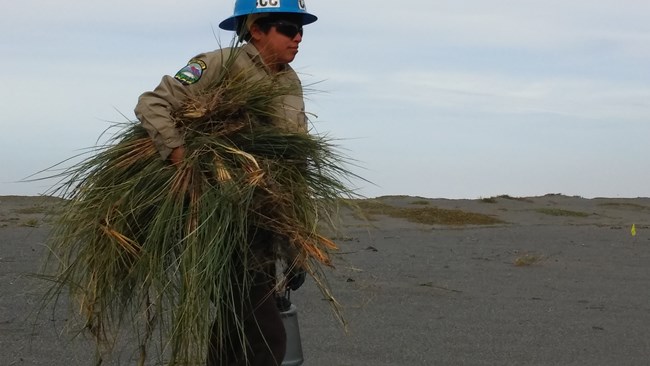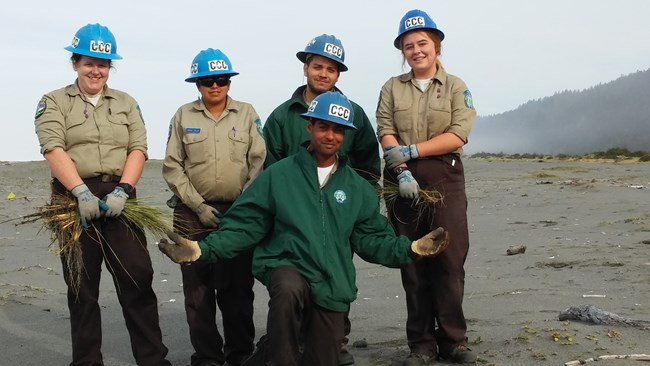Redwood National and State Parks staff, as well as CCC volunteers have been successful in removing invasive European Beach Grass from hundreds of acres of important dune habitats. This invasive species is meeting its match. Michelle Forys. California State Park Environmental Scientist
Article
Gold Bluffs Beach Dune Restoration

NPS: G Litten
Beachgrass also threatens the Pacific Coast population of western snowy plovers (Charadrius nivosus nivosus), a federally listed shorebird. Loss and modification of habitat resulting from beachgrass invasion, urban development, recreation activities, and predation exacerbated by human disturbance were found to be largely responsible for the decline of this species. Removal of beachgrass from the project area is anticipated to result in the enhancement of breeding habitat for snowy plovers.

The project area will be retreated 3 times a year until the beachgrass infestations are at a maintenance level (one retreatment a year).
Although the majority of the project area was covered in beachgrass patches of native dune vegetation persisted, and beachgrass in those areas were treated by hand to preserve the native vegetation. Seeds from the native vegetation have begun to disperse into the mechanically treated areas. To enhance the native plant recruitment additional seeding with native dune plants was conducted in 2013 and 2015. Species that were collected on site and used for seeding the treatment area included yellow sand verbena (Abronia latifolia), pink sand verbena, and American glehnia. In addition, several dozen beach strawberry (Fragaria chiloensis) and beach evening primrose (Camissoniopsis cheiranthifolia) were transplanted into the treatment area.
After only a few years the dunes system in the treatment area has begun to rebound. Prior to initial treatment there was one occurrence of pink sand verbena consisting of 5 individual plants scattered over a 3.7-acre area. In 2016, there were 165 occurrences of pink sand verbena consisting of approximately 2,160 individuals spread throughout the project area. Since implementation began in 2012 snowy plovers have consistently been observed within and adjacent to the treatment area at Gold Bluffs Beach. Park managers plan to continue restoration efforts as funding becomes available.
Before and After Beachgrass Removal at Gold Bluffs Beach


Left image
Before removal of beachgrass
Right image
After removal of beachgrass
Last updated: August 18, 2017
